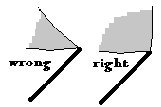| The
spinnaker is a
challenging and exciting sail. The vast majority of hairy sailing
stories in most repertoires revolve around the spinnaker. This
underscores
the need for good functional gear as follows:
Spinnaker
Pole:
A good spinnaker
pole
with sturdy, easy-to-use end fittings is essential. There are a
number
of pole systems in use in Wayfarers, (almost) all of which have the
following
in common:
1. a positive,
easily
adjustable uphaul (topping lift) leading aft to the helm
2. permanent
attachment
to the uphaul to facilitate storage along the boom
3. a downhaul
that
is at least partially shock-corded to retract excess downhaul while the
pole is stored along the boom
A
continuous spinnaker
sheet
about 55-58’
long
which on most boats hits the deck just forward of the back tank -
further
aft is possible but has yet to show racing advantages.
The one crucial
spi
sheet cleating need is just aft of each shroud although many boats have
a second set of cleats on or near the centre thwart.
Guy Hook:
To keep the pole
from
skying and the guy (=windward sheet) off the crew’s neck, a guy hook is
essential.
The halyard
should also lead aft to the helm.
Connecting
sheets
and halyard to the spi:
A Bowline (or
other
even fancier knot) is perfectly adequate to tie sheets and halyards to
the spi. To save weight and avoid various potential breakdowns,
assorted
metal connectors (especially snap hooks) should be avoided.
THE
ROUTINE:
Preparations:
1) pre-cleat the
spi
sheet for the first reach before the start
2) just before
mark,
crew releases halyard from stowed position (and often sets pole).
Helm (pre-)sets topping lift for “ball park” pole height.
The Reach
Set:
1) Helm stands
and
steers with his knees as he hoists while crew hikes and plays main if
necessary.
Usually,
the crew also has to briefly strap the jib in tight to free spi which
gets
caught under jib foot.
2) Helm hikes
and
plays main while crew fixes pole.
3) Crew takes
sheet.
The Run
Set:
Helm hoists,
then
plays both sheets til crew has set pole.
The
Windward Set
can be tricky, especially on a reach. Those who try a windward
set,
usually opt for the “chucker”: the crew bundles the spi and on the
count
of three, the crews throws while the skipper QUICKLY hoists.
Playing
the spi:
Pole height:
The outboard pole end should be just high enough to give the spi luff a
nice fair vertical curve - lower than that if, on a close reach, we
want
to loosen the spi leech to reduce
backwind in
main.
Pole much lower than normal if the wind is too weak to lift spi cloth
easily.
Pole fore/aft
angle:
Bring pole aft until spi shows that it needs to be further forward,
i.e.
the angle made by luff and foot gets down near or, God forbid,
below
90º (see diagram below)

The Gybe:
Ideally, the
crew
does all the sheet work on a reach-to-reach gybe, especially in a blow
where the helm is busy steering through the gybe. see also the “balls
system” which permits us to easily pre-set the new windward sheet
for
a reach.
Then the crew’s
only
other duty just prior to the gybe is to bring (most of) the spi to the
side that’s about to become leeward.
During and right
after
the gybe, our first priorities are
1) keep the boat
under
control, and
2) keep the boat
tracking
away from the mark and protect our wind by ensuring that both main and
jib are played properly.
The spi is
ignored
until that is taken care of.
Lastly, the crew
switches
the pole and sheets in.
On a run-to-run
gybe,
helm takes both sheets and steers through gybe with his knees while
trying
to keep spi flying until crew is ready to take the sheet. Unless it's
survival
time, in which case, I concentrate on gybing with my hand on the tiller
and let the crew do the rest!
The
Take-Down:
Always to
windward!!
Helm checks that
the
halyard is not tangled by holding it up over his head while standing
up,
as the crew steps in front of the windward jib sheet and stows the pole.
We do this early
unless
severely pressed to maintain buoy room, etc. On a run, the pole
comes
down really early, as the helm can easily take the sheets and keep the
spi flying without the pole. At word from helm, crew quickly
drags
spi down while helm exerts gentle resistance by holding halyard (and in
wild weather, the sheet!) in one hand, i.e. crew has to pull these away
from helm so the spi and/or sheet cannot accidentally get under the bow
by simply being let go.
To help us to
keep
from sailing over the sheet we also have a little 4” stainless steel
wire
loop sticking out from bow at deck level.
STOWAGE:
The Spi is very
quickly
dumped into its bag or onto the floor as it comes down - make sure
it stows in
front
of windward jib sheet by having the crew step in front of that jib
sheet
before the take-down!!
The Pole goes
along
the boom, being supported at its aft end by a loop about 5’6” aft along
the boom, and at its forward end, by its permanent residence in the
topping
lift.
After the pole
comes
in, the bow end will be angled up. If desired, this can be
adjusted
by the helm as time permits. We have the correct spot for level
pole
stowage marked on the topping lift.
To keep the
halyard
out of the crew’s face, we run it around a hook near the shroud and
then
into a small black clam-cleat near the mast which keeps most of the
halyard
alongside the shroud.
.....
WIT home page
|
